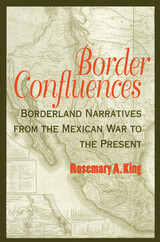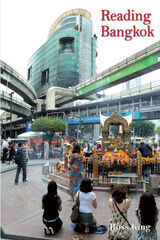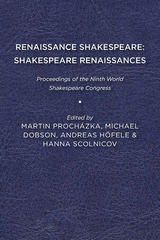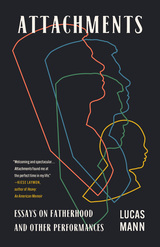4 books by King, Ros

Border Confluences
Borderland Narratives from the Mexican War to the Present
Rosemary A. King
University of Arizona Press, 2004
Writers focusing on the U.S.-Mexico border are keen observers of cultural interaction, and their work offers a key to understanding the region and its most important issues. For more than 150 years, novelists from both the United States and Mexico have spun stories about the borderlands in which characters react to cultural differences in the region, and this has become a dominant theme in border fiction. Authors such as Helen Hunt Jackson, Carlos Fuentes, Cormac McCarthy, and Leslie Marmon Silko have not only created important literature; in so doing, they have also helped define the border. Writers who are drawn to the borderlands owe the narrative power of their work to compelling relationships between literary constructions of space and artistic expressions of cultural encounter. Rosemary King now offers a new way of understanding the conflicts these writers portray by analyzing their representations of geography and genre. Border Confluences examines how the theme of cultural difference influences the ways that writers construct narrative space and the ways their characters negotiate those spaces, from domestic sphere to national territory, public school to utopia. King shows how fictional characters' various responses to cultural encounters—adapting, resisting, challenging, sympathizing—depend on the artistic rendering of spaces and places around them, and she examines the connection between writers' evocation of place and the presence of cultural interaction along the border as expressed in novels written since the mid-nineteenth century. Drawing on historical romances, Hispanic coming-of-age novels, travel narratives, and utopian literature, King offers plot summaries of such key works as Ramona, All the Pretty Horses, and Almanac of the Dead as she analyzes representations of both the spaces in which characters function and the places they inhabit relative to the border. Border Confluences is a provocative study that offers insight into the ways words and space combine and recombine over time to create representations of the borderlands as a site where places and cultures continue to generate powerful narrative. Through it, scholars and students in such disciplines as ethnic studies, sociology, and women's studies will find that novels centered on the border are not merely works of literature but also keys to understanding the region and its most important issues.
[more]

Korea Letters in the William Elliot Griffis Collection
An Annotated Selection
Young-mee Yu Cho
Rutgers University Press, 2024
William Elliot Griffis (1843 – 1928) graduated from Rutgers College in 1869 and taught four years in Fukui and Tokyo. After his return to the United States, he devoted himself to his research and writing on East Asia throughout his life. He authored 20 books about Japan and five books about Korea including, Corea: The Hermit Nation (1882), Corea, Without and Within: Chapters on Corean History, Manners and Religion (1885), The Unmannerly Tiger, and Other Korean Tales (1911), A Modern Pioneer in Korea: The Life Story of Henry G. Appenzeller (1912), and Korean Fairy Tales (1922). In particular, his bestseller, Corea: The Hermit Nation (1882) was reprinted numerous times through nine editions over thirty years. He was not only known as "the foremost interpreter of Japan to the West before World War I but also the American expert on Korea. After his death, his collection of books, documents, photographs and ephemera was donated to Rutgers.
The Korean materials in the Griffis Collection at Rutgers University consist of journals, correspondence, articles, maps, prints, photos, postcards, manuscripts, scrapbooks, and ephemera. These papers reflect Griffis's interests and activities in relation to Korea as a historian, scholar, and theologian. They provide a rare window into the turbulent period of late nineteenth- and twentieth-century Korea, witnessed and evaluated by Griffis and early American missionaries in East Asia. The Korea Letters in the William Elliot Griffis Collection are divided into two parts: letters from missionaries and letters from Japanese and Korean political figures. Newly available and accessible through this collection, these letters develop a multifaceted history of early American missionaries in Korea, the Korean independence movement, and Griffis's views on Korean culture.
The Korean materials in the Griffis Collection at Rutgers University consist of journals, correspondence, articles, maps, prints, photos, postcards, manuscripts, scrapbooks, and ephemera. These papers reflect Griffis's interests and activities in relation to Korea as a historian, scholar, and theologian. They provide a rare window into the turbulent period of late nineteenth- and twentieth-century Korea, witnessed and evaluated by Griffis and early American missionaries in East Asia. The Korea Letters in the William Elliot Griffis Collection are divided into two parts: letters from missionaries and letters from Japanese and Korean political figures. Newly available and accessible through this collection, these letters develop a multifaceted history of early American missionaries in Korea, the Korean independence movement, and Griffis's views on Korean culture.
[more]

Reading Bangkok
Ross King
National University of Singapore Press, 2011
Reading Bangkok presents stories and meanings derived from the built fabric and spaces of Thailand's capital city. The narrative shifts from King Taksin's mostly forgotten but wondrous Thonburi to the tourist spectacle of Rattanakosin, Dusit and Ratchadamnoen (King Rama V's superficial emulation of an admired, imperialist Europe), Sukhumvit "Road" (consumer land), and the slums that are an integral part of the modern city.
The author structures the book around external intrusions and local resistance. Geographically, this process is seen in movement from centre to periphery (Thonburi, Rattanakosin, Ratchadamnoen, Sukhumvit, Ratchadapisek, Khlong Toei, the universities). Chronologically, the city underwent various forms of colonization: incorporation of the periphery, which in turn colonized Bangkok; the economic colonization of the 19th and 20th centuries; colonization by consumption brought on in large part by globalized tourism; colonization by the "better" ideas of others (typically from the West); and finally colonization by "better" ways of thinking - notably the intrusions of the universities and of popular democracy.
This exceptionally innovative study draws on urban planning and development, history, anthropology, and political economy, and a rich body of empirical data to provide insights into the maze of power relations, inequalities and global influences that is normally hidden from view. Reading Bangkok is that rare thing, a study that genuinely changes the way its subject is seen and understood.
The author structures the book around external intrusions and local resistance. Geographically, this process is seen in movement from centre to periphery (Thonburi, Rattanakosin, Ratchadamnoen, Sukhumvit, Ratchadapisek, Khlong Toei, the universities). Chronologically, the city underwent various forms of colonization: incorporation of the periphery, which in turn colonized Bangkok; the economic colonization of the 19th and 20th centuries; colonization by consumption brought on in large part by globalized tourism; colonization by the "better" ideas of others (typically from the West); and finally colonization by "better" ways of thinking - notably the intrusions of the universities and of popular democracy.
This exceptionally innovative study draws on urban planning and development, history, anthropology, and political economy, and a rich body of empirical data to provide insights into the maze of power relations, inequalities and global influences that is normally hidden from view. Reading Bangkok is that rare thing, a study that genuinely changes the way its subject is seen and understood.
[more]

Renaissance Shakespeare/Shakespeare Renaissances
Proceedings of the Ninth World Shakespeare Congress
Martin Procházka
University of Delaware Press, 2014
Selected contributions to the Ninth World Shakespeare Congress, which took place in July 2011 in Prague, represent the contemporary state of Shakespeare studies in thirty-eight countries worldwide. Apart from readings of Shakespeare’s plays and poems, more than forty chapters map Renaissance contexts of his art in politics, theater, law, or material culture and discuss numerous cases of the impact of his works in global culture from the Americas to the Far East, including stage productions, book culture, translations, film and television adaptations, festivals, and national heritage. The last section of the book focuses on the afterlife of Shakespeare in the work of the leading British dramatist Tom Stoppard.
Published by University of Delaware Press. Distributed worldwide by Rutgers University Press.
Published by University of Delaware Press. Distributed worldwide by Rutgers University Press.
[more]
READERS
Browse our collection.
PUBLISHERS
See BiblioVault's publisher services.
STUDENT SERVICES
Files for college accessibility offices.
UChicago Accessibility Resources
home | accessibility | search | about | contact us
BiblioVault ® 2001 - 2024
The University of Chicago Press









